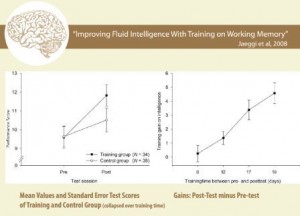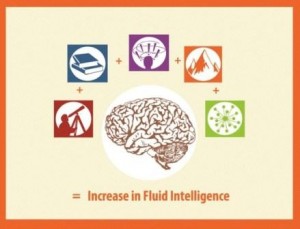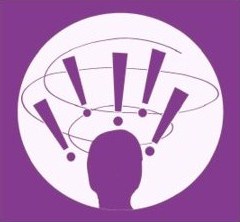 From March 7th, 2011
From March 7th, 2011
“One should not pursue goals that are easily achieved. One must develop an instinct for what one can just barely achieve through one’s greatest efforts.” —Albert Einstein
While Einstein was not a neuroscientist, he sure knew what he was talking about in regards to the human capacity to achieve. He knew intuitively what we can now show with data—what it takes to function at your cognitive best. In essence: What doesn’t kill you makes you smarter.
Not so many years ago, I was told by a professor of mine that you didn’t have much control over your intelligence. It was genetic—determined at birth. He explained that efforts made to raise the intelligence of children (through programs like Head Start, for example) had limited success while they were in practice, and furthermore, once the “training” stopped, they went right back to their previously low cognitive levels. Indeed, the data did show that [pdf], and he (along with many other intelligence researchers) concluded that intelligence could not be improved—at least not to create a lasting change.
Well, I disagreed.
You see, before that point in my studies, I had begun working as a Behavior Therapist, training young children on the autism spectrum. These kids had a range of cognitive disabilities—my job was to train them in any and all areas that were deficient, to get them as close to functioning at the same level of their peers as possible. Therapy utilized a variety of methods, or Multimodal Teaching (using as many modes of input as possible), in order to make this happen.
One of my first clients was a little boy w/ PDD-NOS (Pervasive Developmental Delays-Not Otherwise Specified), a mild form of autism. When we began therapy, his IQ was tested and scored in the low 80s—which is considered borderline mental retardation. After I worked with him for about three years— one on one, teaching in areas such as communication, reading, math, social functioning, play skills, leisure activities—using multimodal techniques [pdf] —he was retested. His IQ score was well over 100 (with 100 considered “average”, as compared to the general population). That’s a 20 point increase, more than one standard deviation improvement, by a child with an autism spectrum disorder!
He wasn’t the only child I saw make vast improvements in the years I’ve been a therapist, either. I’ve been fortunate enough to see many children grow by leaps and bounds—not by magic, and not even by taking medication, and there’s data to show proof of their gains. I thought—if these kids with severe learning impediments could make such amazing progress, with that progress carrying over into every aspect of their cognitive functioning—why can’t an average person make those kinds of gains as well? Or even more gains, considering they don’t have the additional challenge of an autism spectrum disorder?
Although the data from those early studies showed dismal results, I wasn’t discouraged. I still believed it was possible to significantly increase your cognitive functioning, given the proper training—since I had seen it with my own eyes through my work as a therapist.
Then in 2008, a very exciting study was published, Improving Fluid Intelligence with Training on Working Memory, by Jaeggi, Buschkuehl, Jonides, and Perrig. This study was pretty much a game-changer for those doing research on this topic. They showed for the first time, that it might actually be possible to increase your intelligence to a significant degree through training. What did they do different?
The subjects in Jaeggi’s study were trained on an intensive, multimodal (visual and auditory input) working memory task (the dual-n-back) [1] for variable lengths of time, for either one or two weeks, depending on the group. Following this training, they were tested to see how much they improved. As one would expect, after training, their scores on that task got better. But they went a step further. They wanted to see if those gains on the training task could transfer to an increase in skill on a completely different test of cognitive ability, which would indicate an increase in overall cognitive ability. What did they find?
Following training of working memory using the dual n-back test, the subjects were indeed able to transfer those gains to a significant improvement in their score on a completely unrelated cognitive task. This was a super-big deal.
Here’s the graph of their results, and you can read about the entire study here.

What is “Intelligence”?
First of all, let me explain what I mean when I say the word “intelligence”. To be clear, I’m not just talking about increasing the volume of facts or bits of knowledge you can accumulate, or what is referred to as crystallized intelligence—this isn’t fluency or memorization training—it’s almost the opposite, actually. I’m talking about increasing your fluid intelligence, or your capacity to learn new information, retain it, then use that new knowledge as a foundation to solve the next problem, or learn the next new skill, and so on.
Now, while working memory is not synonymous with intelligence, working memorycorrelates with intelligence to a large degree. In order to generate successfully intelligent output, a good working memory is pretty important. So to make the most of your intelligence, improving your working memory will help this significantly—like using the very best and latest parts to help a machine to perform at its peak.
The take-home points from this research? This study is relevant because they discovered:
1. Fluid intelligence is trainable.
2. The training and subsequent gains are dose-dependent—meaning, the more you train, the more you gain.
3. Anyone can increase their cognitive ability, no matter what your starting point is.
4. The effect can be gained by training on tasks that don’t resemble the test questions.
How Can I Put This Research To Practical Use For My Own Benefit?
There is a reason why the dual n-back task was so successful at increasing cognitive ability. It involves dividing your attention between competing stimuli, multimodal in fashion (one visual, one auditory). It requires you to focus on specific details while ignoring irrelevant information, which helps to improve your working memory over time, gradually increasing your ability to multi-task the information effectively. In addition, the stimulus was constantly switched, so there was never a “training to the test questions” phenomenon—it was always different. If you’ve never taken the dual n-back test, let me tell you this: It’s wicked hard. I’m not surprised there was so much cognitive gain from practicing this activity.
But let’s think practically.
Eventually, you will run out of cards in the deck or sounds in the array (the experiment lasted 2 weeks), so it isn’t practical to think that if you want to continually increase your brain power over the course of your lifetime, that the dual n-back alone will do the trick. Also, you’ll get bored with it and stop doing it. I know I would. Not to mention the time it takes to train in this activity—we all have busy lives! So we need to think of how to simulate the same types of heavy-duty brain thrashing—using multimodal methods—that can be applied to your normal life, while still maintaining the maximum benefits, in order to get the cognitive growth.
So—taking all of this into account, I have come up with five primary elements involved in increasing your fluid intelligence, or cognitive ability. Like I said, it would be impractical to constantly practice the dual n-back task or variations thereof every day for the rest of your life to reap cognitive benefits. But it isn’t impractical to adopt lifestyle changes that will have the same—and even greater cognitive benefits. These can be implemented every day, to get you the benefits of intense entire-brain training, and should transfer to gains in overall cognitive functioning as well.
These five primary principles are:
1. Seek Novelty
2. Challenge Yourself
3. Think Creatively
4. Do Things The Hard Way
5. Network

Any one of these things by itself is great, but if you really want to function at your absolute cognitive best, you should do all five, and as often as possible. In fact, I live my life by these five principles. If you adopt these as fundamental guidelines, I guarantee you will be performing at your peak ability, surpassing even what you believe you are capable of—all without artificial enhancement. Best part: Science supports these principles by way of data!

1. Seek Novelty
It is no coincidence that geniuses like Einstein were skilled in multiple areas, or polymaths, as we like to refer to them. Geniuses are constantly seeking out novel activities, learning a new domain. It’s their personality.
There is only one trait out of the “Big Five” from the Five Factor Model of personality (Acronym: OCEAN, or Openness, Conscientiousness, Extroversion, Agreeableness, and Neuroticism) that correlates with IQ, and it is the trait of Openness to new experience. People who rate high on Openness are constantly seeking new information, new activities to engage in, new things to learn—new experiences in general [2].
When you seek novelty, several things are going on. First of all, you are creating new synaptic connections with every new activity you engage in. These connections build on each other, increasing your neural activity, creating more connections to build on other connections—learning is taking place.
An area of interest in recent research [pdf] is neural plasticity as a factor in individual differences in intelligence. Plasticity is referring to the number of connections made between neurons, how that affects subsequent connections, and how long-lasting those connections are. Basically, it means how much new information you are able to take in, and if you are able to retain it, making lasting changes to your brain. Constantly exposing yourself to new things helps puts your brain in a primed state for learning.
Novelty also triggers dopamine (I have mentioned this before in other posts), which not only kicks motivation into high gear, but it stimulates neurogenesis—the creation of new neurons—and prepares your brain for learning. All you need to do is feed the hunger.
Excellent learning condition =
Novel Activity—>triggers dopamine—>creates a higher motivational state—>which fuels engagement and primes neurons—>neurogenesis can take place + increase in synaptic plasticity (increase in new neural connections, or learning).
As a follow-up of the Jaeggi study, researchers in Sweden [pdf] found that after 14 hours of training working memory over 5 weeks’ time, there was an increase ofdopamine D1 binding potential in the prefrontal and parietal areas of the brain. This particular dopamine receptor, the D1 type, is associated with neural growth and development, among other things. This increase in plasticity, allowing greater binding of this receptor, is a very good thing for maximizing cognitive functioning.
Take home point: Be an “Einstein”. Always look to new activities to engage your mind—expand your cognitive horizons. Learn an instrument. Take an art class. Go to a museum. Read about a new area of science. Be a knowledge junkie.
 2. Challenge Yourself
2. Challenge Yourself
There are absolutely oodles of terrible things written and promoted on how to “train your brain” to “get smarter”. When I speak of “brain training games”, I’m referring to the memorization and fluency-type games, intended to increase your speed of processing, etc, such as Sudoku, that they tell you to do in your “idle time” (complete oxymoron, regarding increasing cognition). I’m going to shatter some of that stuff you’ve previously heard about brain training games. Here goes: They don’t work. Individual brain training games don’t make you smarter—they make you more proficient at the brain training games.
Now, they do serve a purpose, but it is short-lived. The key to getting something out of those types of cognitive activities sort of relates to the first principle of seeking novelty. Once you master one of those cognitive activities in the brain-training game, you need to move on to the next challenging activity. Figure out how to play Sudoku? Great! Now move along to the next type of challenging game. There is research that supports this logic.
A few years ago, scientist Richard Haier wanted to see if you could increase your cognitive ability by intensely training on novel mental activities for a period of several weeks. They used the video game Tetris as the novel activity, and used people who had never played the game before as subjects (I know—can you believe they exist?!). What they found, was that after training for several weeks on the game Tetris, the subjects experienced an increase in cortical thickness, as well as an increase in cortical activity, as evidenced by the increase in how much glucose was used in that area of the brain. Basically, the brain used more energy during those training times, and bulked up in thickness—which means more neural connections, or new learned expertise—after this intense training. And they became experts at Tetris. Cool, right?
Here’s the thing: After that initial explosion of cognitive growth, they noticed adecline in both cortical thickness, as well as the amount of glucose used during that task. However, they remained just as good at Tetris; their skill did not decrease. The brain scans showed less brain activity during the game-playing, instead of more, as in the previous days. Why the drop? Their brains got more efficient. Once their brain figured out how to play Tetris, and got really good at it, it got lazy. It didn’t need to work as hard in order to play the game well, so the cognitive energy and the glucose went somewhere else instead.
Efficiency is not your friend when it comes to cognitive growth. In order to keep your brain making new connections and keeping them active, you need to keep moving on to another challenging activity as soon as you reach the point of masteryin the one you are engaging in. You want to be in a constant state of slight discomfort, struggling to barely achieve whatever it is you are trying to do, as Einstein alluded to in his quote. This keeps your brain on its toes, so to speak. We’ll come back to this point later on.
 3. Think Creatively
3. Think Creatively
When I say thinking creatively will help you achieve neural growth, I am not talking about painting a picture, or doing something artsy, like we discussed in the first principle, Seeking Novelty. When I speak of creative thinking, I am talking about creative cognition itself, and what that means as far as the process going on in your brain.
Contrary to popular belief, creative thinking does not equal “thinking with the right side of your brain”. It involves recruitment from both halves of your brain, not just the right. Creative cognition involves divergent thinking (a wide range of topics/subjects), making remote associations between ideas, switching back and forth between conventional and unconventional thinking (cognitive flexibility), and generating original, novel ideas that are also appropriate to the activity you are doing. In order to do this well, you need both right and left hemispheres working in conjunction with each other.
Several years ago, Dr Robert Sternberg, former Dean at Tufts University, opened thePACE (Psychology of Abilities, Competencies, and Expertise) Center, in Boston. Sternberg has been on a quest to not only understand the fundamental concept of intelligence, but also to find ways in which any one person can maximize his or her intelligence through training, and especially, through teaching in schools.
Here Sternberg describes the goals of the PACE Center, which was started at Yale:
“The basic idea of the center is that abilities are not fixed but rather flexible, that they’re modifiable, and that anyone can transform their abilities into competencies, and their competencies into expertise,” Sternberg explains. “We’re especially interested in how we can help people essentially modify their abilities so that they can be better able to face the tasks and situations they’re going to confront in life.”
As part of a research study, The Rainbow Project [pdf], he created not only innovative methods of creative teaching in the classroom, but generated assessment procedures that tested the students in ways that got them to think about the problems in creative and practical ways, as well as analytical, instead of just memorizing facts.
Sternberg explains,
“In the Rainbow Project we created assessments of creative and practical as well as analytical abilities. A creative test might be: ‘Here’s a cartoon. Caption it.’ A practical problem might be a movie of a student going into a party, looking around, not knowing anyone, and obviously feeling uncomfortable. What should the student do?”
He wanted to find out if by teaching students to think creatively (and practically)about a problem, as well as for memory, he could get them to (i) Learn more about the topic, (ii) Have more fun learning, and (iii) Transfer that knowledge gained to other areas of academic performance. He wanted to see if by varying the teaching and assessment methods, he could prevent “teaching to the test” and get the students to actually learn more in general. He collected data on this, and boy, did he get great results.
In a nutshell? On average, the students in the test group (the ones taught using creative methods) received higher final grades in the college course than the control group (taught with traditional methods and assessments). But—just to make things fair— he also gave the test group the very same analytical-type exam that the regular students got (a multiple choice test), and they scored higher on that test as well. That means they were able to transfer the knowledge they gained using creative, multimodal teaching methods, and score higher on a completely different cognitive test of achievement on that same material. Sound familiar?
 4. Do Things the Hard Way
4. Do Things the Hard Way
I mentioned earlier that efficiency is not your friend if you are trying to increase your intelligence. Unfortunately, many things in life are centered on trying to make everything more efficient. This is so we can do more things, in a shorter amount of time, expending the least amount of physical and mental energy possible. However, this isn’t doing your brain any favors.
Take one object of modern convenience, GPS. GPS is an amazing invention. I am one of those people GPS was invented for. My sense of direction is terrible. I get lost all the time. So when GPS came along, I was thanking my lucky stars. But you know what? After using GPS for a short time, I found that my sense of direction was worse. If I failed to have it with me, I was even more lost than before. So when I moved to Boston—the city that horror movies and nightmares about getting lost are modeled after—I stopped using GPS.
I won’t lie—it was painful as hell. I had a new job which involved traveling all over the burbs of Boston, and I got lost every single day for at least 4 weeks. I got lost so much, I thought I was going to lose my job due to chronic lateness (I even got written up for it). But—in time, I started learning my way around, due to the sheer amount of practice I was getting at navigation using only my brain and a map. I began to actually get a sense of where things in Boston were, using logic and memory, not GPS. I can still remember how proud I was the day a friend was in town visiting, and I was able to effectively find his hotel downtown with only a name and a location description to go on—not even an address. It was like I had graduated from navigational awareness school.
Technology does a lot to make things in life easier, faster, more efficient, but sometimes our cognitive skills can suffer as a result of these shortcuts, and hurt us in the long run. Now, before everyone starts screaming and emailing my transhumanist friends to say that I’ve sinned by trashing tech—that’s not what I’m doing.
Look at it this way: Driving to work takes less physical energy, saves time, and it’s probably more convenient and pleasant than walking. Not a big deal. But if you drove everywhere you went, or spent your life on a Segway, even to go very short distances, you aren’t going to be expending any physical energy. Over time, your muscles will atrophy, your physical state will weaken, and you’ll probably gain weight. Your overall health will probably decline as a result.
Your brain needs exercise as well. If you stop using your problem-solving skills, your spatial skills, your logical skills, your cognitive skills—how do you expect your brain to stay in top shape—never mind improve? Think about modern conveniences that are helpful, but when relied on too much, can hurt your skill in that domain. Translation software: amazing, but my multilingual skills have declined since I started using it more. I’ve now forced myself to struggle through translations before I look up the correct format. Same goes for spell-check and autocorrect. In fact, I think autocorrect was one of the worst things ever invented for the advancement of cognition. You know the computer will catch your mistakes, so you plug along, not even thinking about how to spell any more. As a result of years of relying on autocorrect and spell-check, as a nation, are we worse spellers? (I would love someone to do a study on this.)
There are times when using technology is warranted and necessary. But there are times when it’s better to say no to shortcuts and use your brain, as long as you can afford the luxury of time and energy. Walking to work every so often or taking the stairs instead of the elevator a few times a week is recommended to stay in good physical shape. Don’t you want your brain to be fit as well? Lay off the GPS once in a while, and do your spatial and problem-solving skills a favor. Keep it handy, but try navigating naked first. Your brain will thank you.
 5. Network
5. Network
And that brings us to the last element to maximize your cognitive potential: Networking. What’s great about this last objective is that if you are doing the other four things, you are probably already doing this as well. If not, start. Immediately.
By networking with other people—either through social media such as Facebook or Twitter, or in face-to-face interactions—you are exposing yourself to the kinds of situations that are going to make objectives 1-4 much easier to achieve. By exposing yourself to new people, ideas, and environments, you are opening yourself up to new opportunities for cognitive growth. Being in the presence of other people who may be outside of your immediate field gives you opportunities to see problems from a new perspective, or offer insight in ways that you had never thought of before. Learning is all about exposing yourself to new things and taking in that information in ways that are meaningful and unique—networking with other people is a great way to make that happen. I’m not even going to get into the social benefits and emotional well-being that is derived from networking as a factor here, but that is just an added perk.
Steven Johnson, author who wrote the book “Where Good Ideas Come From”, discusses the importance of groups and networks for the advancement of ideas. If you are looking for ways to seek out novel situations, ideas, environments, and perspectives, then networking is the answer. It would be pretty tough to implement this “Get Smarter” regiment without making networking a primary component. Greatest thing about networking: Everyone involved benefits. Collective intelligence for the win!
And I have one more thing to mention…
Remember back to the beginning of this article where I told the story about my clients with autism spectrum disorders? Let’s think about that for a moment, in light of everything else we discussed about how to increase your fluid intelligence. Why were those children able to achieve at such a high level? It was not by chance or miracle—it was because we incorporated all of these learning principles into their therapy program. While most other therapy providers were stuck in the “Errorless Learning” paradigm and barely-modified “Lovaas Techniques” of Applied Behavior Analysis, we adopted and fully embraced a multimodal approach to teaching. We made the kids struggle to learn, we used the most creative ways we could think of, and we challenged them beyond what they seemed capable of—we set the bar very high. But you know what? They surpassed that bar time and time again, and made me truly believe that amazing things are possible if you have enough will and courage and perseverance to set yourself on that path and stick with it. If those kids with disabilities can live this lifestyle of constantly maximizing their cognitive potential, then so can you.
And I have a departing question for you to ponder as well: If we have all of this supporting data, showing that these teaching methods and ways of approaching learning can have such a profound positive effect on cognitive growth, why aren’t more therapy programs or school systems adopting some of these techniques? I’d love to see this as the standard in teaching, not the exception. Let’s try something novel and shake up the education system a little bit, shall we? We’d raise the collective IQ something fierce.
Intelligence isn’t just about how many levels of math courses you’ve taken, how fast you can solve an algorithm, or how many vocabulary words you know that are over 6 characters. It’s about being able to approach a new problem, recognize its important components, and solve it—then take that knowledge gained and put it towards solving the next, more complex problem. It’s about innovation and imagination, and about being able to put that to use to make the world a better place. This is the kind of intelligence that is valuable, and this is the type of intelligence we should be striving for and encouraging.
This article is adapted from a presentation I gave at the Humanity + Summit at Harvard University in June 2010.
[1.] The dual n-back test, while lumped into the “brain training” genre, is not your typical brain training game. It is specific and complicated, uses multiple modes of stimuli, and not the type I’m referring to when I say “brain training games”.
[2.] “Openness” or novelty-seeking is not the same as thrill-seeking behavior. The motivation for the former is driven by dopamine, and associated with curiosity—the latter by adrenaline, and typically associated with more dangerous activities.
Works Cited:
Garlick, D. (2002). Understanding the Nature of the General Factor of Intelligence: The Role of Individual Differences in Neural Plasticity as an Explanatory Mechanism. Psychological Review, 109, no.1 , 116-136.
Haier, R. E. (2007). The Parieto-Frontal Integration Theory (P-FIT) of Intelligence: Converging Neuroinaging Evidence. Behavioral and Brain Sciences, 135-187.
Haier, R. J. (1993). Cerebral glucose metabolism and intelligence. In P. A. Vernon,Biological approaches to the study of human intelligence (pp. 317-373). Norwood, N. J.: Ablex.
Susanne M. Jaeggi, M. B. (2008). Improving Fluid intelligence With Training on Working Memory. Proceedings of the National Academy of Sciences. doi: 10.1073/pnas.0801268105
Ramey, C. T. (1998). Early Intervention and Early Experience. American Psychologist, 109-120.
Sternberg, R. (2008). Increasing Fluid Intelligence is Possible After All. PNAS, 105, no. 19 , 6791- 6792.
Sternberg, R. J. (1985). Implicit Theories of Intelligence, Creativity, and Wisdom.Journal of Personality and Social Psychology, 49 , 607-627.
Sternberg, R. J. (1999). The Theory of Sucessful Intelligence. Review of General Psychology, 3 , 292-316.
Weinberg, R. (1989). Intelligence and IQ. American Psychologist, 98-104.
Image Credits: Andrea Kuszewski








